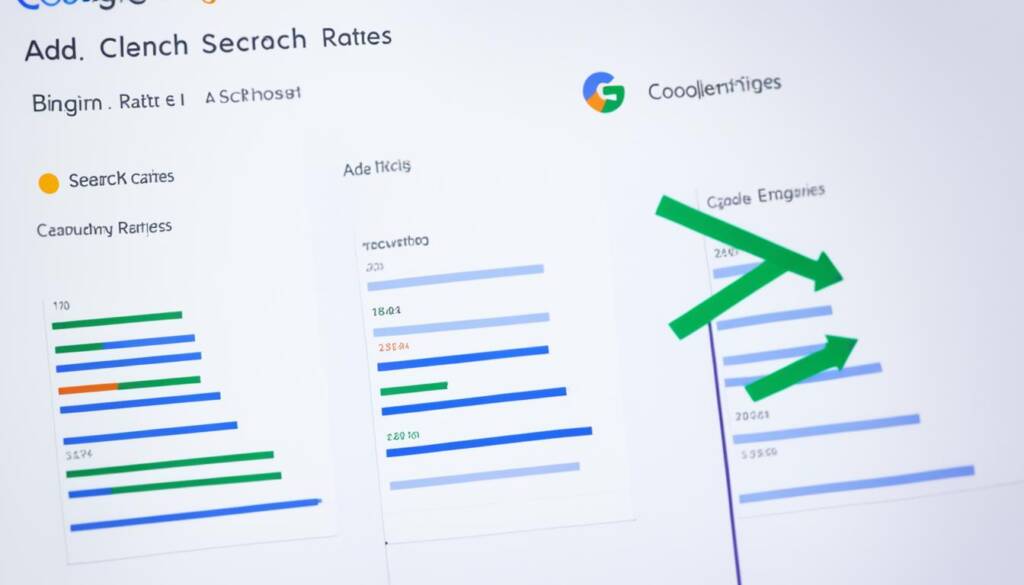Understanding the strategies between Google Ads vs Bing Ads is crucial for businesses always looking for the best way to reach their audience online. Google Ads lead with an 85% market share, while Bing Ads take around 9%. But don’t overlook Bing Ads, as they can reach 63 million users Google misses. When advertising online, we must think about reach, cost, and how well it converts users.

Bing Ads offer a big advantage with costs up to 70% lower than Google Ads2. They also attract a wealthier, older audience, perfect for B2B marketing1. Google’s Display Network, reaching over a billion users a month, is huge1. Our goal is to use both platforms well to make a strong digital marketing plan.
Key Takeaways
- Google Ads dominate with 85% market share whereas Bing Ads hold around 9%1.
- Bing Ads can access 63 million searchers not reached by Google Ads2.
- Bing Ads feature lower CPCs, up to 70% beneath those of Google Ads2.
- Google’s Display Network reaches over a billion users per month1.
- Bing Ads are particularly effective for targeting affluent, older demographics1.
Google Ads: Features and Advantages
Google Ads is a key tool for businesses wanting to boost their online marketing with targeted PPC ads. It offers many features and benefits. These help advertisers reach their audience, use different ad types, and track results accurately.
Ad Networks and Formats
Google Ads uses two main ad networks: the Search Network and the Display Network. The Search Network shows text ads on Google’s search results page. The Display Network puts ads on various websites, using formats like images, interactive content, and videos. This variety helps with different content plans and reaching more people. Countdown ads, found in certain ad types, are great for urgent promotions3. Google Ads Smart campaigns also advertise on Google Search, Google Maps, YouTube, Gmail, and other sites, offering a full range of options4.
Keyword Targeting and Reach
Google Ads is great for targeted advertising with precise keyword bidding. Advertisers can focus on specific interests, choose keywords, and set ad locations and demographics. They can even control when and where ads appear5. Google Ads Smart campaigns target by location, language, demographics, and interests, helping businesses aim for specific goals like customer calls or website sales4. This targeted approach ensures ads reach the right people, making a bigger impact.
Cost and Conversion Tracking
Google Ads is flexible with costs. Advertisers can manage their spending easily, with no minimums. They can set budgets by month, day, or per ad5. For Smart campaigns, payment only happens when someone clicks on the ad, or for video ads when viewers engage with it for 30 seconds or more4. Google Ads’ conversion tracking lets advertisers see ad performance closely. It shows when users click and take actions, like buying something or downloading an app5. This detailed tracking helps marketers improve their campaigns and get a better return on investment.
Comparing Bing Ads to Google Ads
When we look at Bing Ads and Google Ads, we see they offer different things for online ads. Google is much bigger, handling almost ten times more searches than Bing67. But Bing Ads have their own perks, especially in search engine marketing.
Google Ads can target over 40 languages, while Microsoft Advertising targets 126. This is key for businesses wanting to reach the world. Yet, Microsoft Ads tend to attract an older audience in the U.S., with 46% over 45 years old7. This could be great for B2B marketers, thanks to Microsoft’s links with Yahoo, MSN, and AOL.
Bing Ads stand out with a higher click-through rate for PPC ads, at 1.25%6. This is more than Google’s 0.86%. Google’s overall click-through rate is 3.17%, while Bing’s is 2.83%7. These numbers show Bing could be a better choice for certain ads.
Bing Ads are often more cost-effective, with lower cost-per-click and fewer competitors. Desktop searchers using Bing or Yahoo spend a lot worldwide, showing a chance for businesses to target affluent users7.
Both platforms have their own strengths in conversion tracking. Google Ads offer call-only ads and detailed call tracking, starting at $30.79 per conversion7. Microsoft Ads, on the other hand, have seen a 20% increase in clicks during testing7.
Using both Bing Ads and Google Ads can help businesses. Google’s big market means it’s more competitive and costly6. But Bing Ads offer a good alternative with targeted reach and lower costs. They provide better keyword and device targeting, helping with campaign management and possibly higher conversions.
Having a good SEM strategy means using the best of both Google Ads and Bing Ads. This approach helps advertisers reach different audiences and cover the market fully.
Conclusion
After comparing Google Ads and Bing Ads, we see both have unique benefits for a strong digital marketing strategy. Using both in your PPC advertising helps you use Google’s wide reach and advanced tools. At the same time, Bing’s cost-effectiveness and access to specific markets add to your strategy.
Google Ads has many campaign types like Search, Display, Shopping, Video, App, and Discovery. These work on a pay-per-click model. This means you only pay when someone clicks on your ad8. Bing Ads also offers great value with its wide audience reach and often lower ad costs. It’s a key part of any search engine marketing plan.
It’s important to know about key metrics like Cost per Click (CPC), Ad Rank, Quality Score, and Expected Click-Through Rate for better ad performance and conversion tracking9. Our Web AI Engine can greatly improve your ad management on both platforms. This leads to better ad placement and a higher return on investment. Using both Google Ads and Bing Ads together helps you reach more people, target your audience better, and run more successful pay-per-click campaigns.
Source Links
- https://brightbid.com/blog/google-ads-vs-bing-ads-what-is-the-difference/
- https://instapage.com/blog/bing-ads-vs-google-ads/
- https://hawksem.com/blog/google-ads-features/
- https://support.google.com/google-ads/answer/7457632?hl=en-GB
- https://support.google.com/google-ads/answer/6123875?hl=en
- https://agencyanalytics.com/blog/microsoft-ads-vs-google-ads
- https://www.spyfu.com/blog/google-ads-vs-bing-ads/
- https://www.linkedin.com/pulse/1-mastering-google-ads-comprehensive-guide-krishanu-chakraborty
- https://www.mobidea.com/academy/google-adwords-overview/


